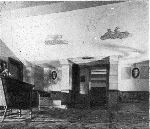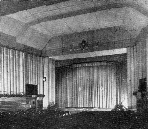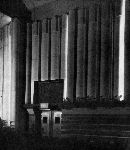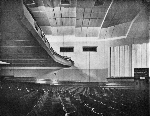(Angus) Playhouse
John Street
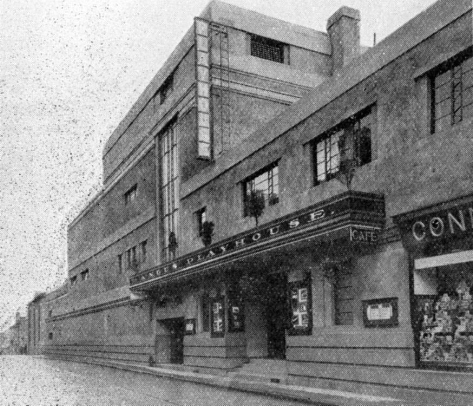
|
The Playhouse opened in 1932, as a sister cinema to the Playhouse Elgin. Both were designed by AG MacDonald, and shared several decorative similarities, including the wood panelling below the dado line in the foyer and auditorium, as well as the (29 ft wide) procenium arch and small stepped stage. Montrose was a little plainer in appearance than Elgin, especially in size and auditorium lighting, originally seating 694 in stalls, 319 in the balcony.
MacDonald's design was however impressive enough to be featured as an excellent example of its type in the 1936 publication 'Modern Cinemas', produced by the Architectural Press. The design had the long axis of the audiorium running parallel to John Street, with separate entrances to the main foyer and a shop and cafe on the right. The auditorium wall surfaces, in green and lavender grey, were also in wallboard, with vertical joints overlapped to create a 3D effect of light and shade when properly illuminated - a trick used again by MacDonald in his 1935 Broadway, Prestwick. The ceiling stepped down towards the screen to improve acoustics. Spotlights on the balcony front (accessed through hatches in the front row) illuminated the screen curtains, and the grilles on the splay walls above the side stalls exits were internally illuminated. One other notable feature of the auditorium (again also present in Prestwick) were the daylight shutters on the side walls, which were rolled up at the end of the night to allow maximum natural light into the auditorium for the cleaners next morning.
Although built for the Angus Playhouse company, the cinema was run by Caledonian Associated Cinemas. The original projection equipment was Simplex projectors and RCA sound, later replaced by BTH throughout when it was taken over by JB Milne Theatres around 1958. The original screen had been 20 ft by 15 ft, and was replaced by a scope screen of 29 ft by 14 ft size. By 1971, the cinema had still never been refurbished, and almost everything - seats, lighting and decoration was intact (if somewhat run down). Seating then was 308 in balcony and 729 in the stalls. The vertical Playhouse sign had gone by this point, and quad poster frames fitted outside.The screen curtains had changed to a festoon-style. Allan Goodall, projectionist at the Playhouse in the 1970s, remembers: "When I worked there as Chief Projectionist in 1971, films mainly changed on Mondays, Wednesdays, and Fridays - occasionally a film would run all week. Sundays were one day shows and usually old films. Performances were from 5.30pm and continuous from 2.00pm on Saturdays, and Sundays usually from 6.30pm. Another feature of JB Milne Theatres - and Montrose was no different - was that there was no carpet in the stalls aisles; it was a green rubber which was easy to clean but could be slippery if liquid was spilt on it." The Playhouse closed on 27th August, 1977, showing 'Bugsy Malone' to a busy final audience of over 600. The building sat empty until 1991, when it was demolished after a fire. Thanks to Chris Doak for the archive materials, and Allan Goodall for facts and figures. |
| King's Cinema Hume Street 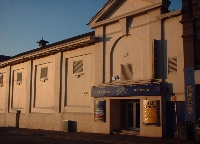
|
11-13 George Street
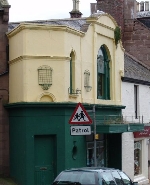
The auditorium is now a car park accessed of Baltic Street where the old shell of the cinema can still be seen
Photo courtesy Derek Mathieson




